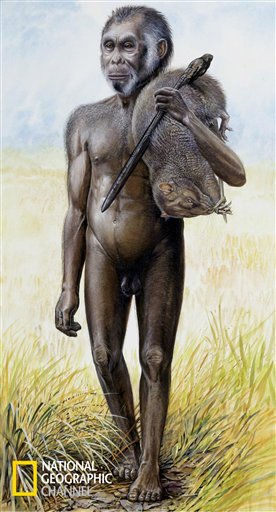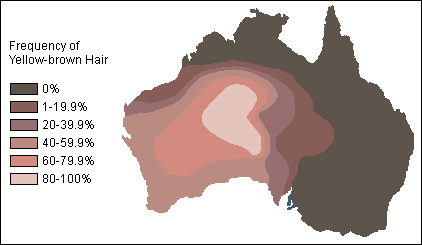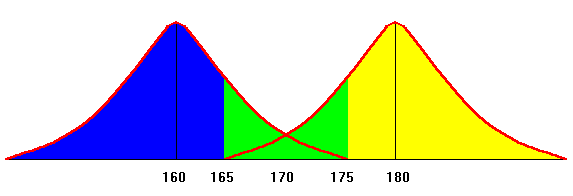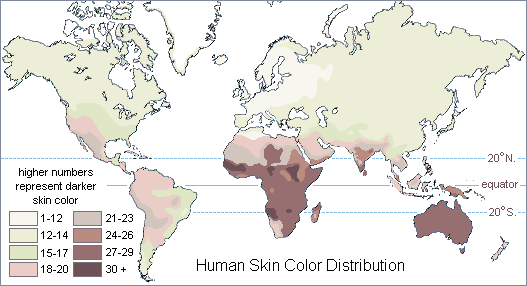 Introduction to Archaeology
and Palaeoanthropology:
Introduction to Archaeology
and Palaeoanthropology:
 Introduction to Archaeology
and Palaeoanthropology:
Introduction to Archaeology
and Palaeoanthropology:
Humanity's Journeys
Dr. Kathryn Denning
Anth 2140, Sept 2005 - Apr 2006
22 Nov 2005... Welcome!
Plan for the day
1 Course business/ announcements...
2 Back to some questions about evolution, and on to modern human diversity... and scientific approaches to it
Schedule
For today/tomorrow: KIT: Modern Human Diversity, Human Variation and Adaptation
Tomorrow in tutorial: Modern human diversity, science and prejudice -- short video and discussion. Come prepared to discuss. (do your reading)
Quiz #3: in lecture on Dec 6th. We will have this at the start of class. Late-comers will not receive extra time. Review notes to be posted shortly.
Next week: Having learned about human biology and evolution, we'll return to archaeology, i.e. more about human history and culture. Fagan chapter 4 and chapter 5.
Returning to some questions from last week
Q: What came before the Miocene hominoids?
This is covered in one of the course kit readings (Macroevolution and the Early Primates, Nov 1). It's also covered in this useful online tutorial:
http://anthro.palomar.edu/earlyprimates/early_1.htm
http://anthro.palomar.edu/earlyprimates/early_2.htm
Or you can check out this nice overview of the Cenozoic era, http://www.mnh.si.edu/anthro/humanorigins/faq/gt/cenozoic/cenozoic.htm which includes the Palaeocene, Eocene, Oligocene, and Miocene. If you click on the timeline there, it will tell you about the primates from each period.
Q: Radiometric dating like C14 -- how do we know that the rate of change has stayed constant in the past?
This is certainly one of the tough parts about radiometric dating. In fact, we know that it hasn't stayed constant... which is why, when professional archaeologists use dates, we always use a +/- factor, e.g. 50 000 +/- 1400 ya (there is a statistical method for generating that +/- factor.) Also, there are sophisticated methods for calibrating our radiocarbon curves. If you'd like to know more, here are some great references: http://www.geo.arizona.edu/palynology/geos462/000references.html, http://www.geo.arizona.edu/palynology/geos462/10radiometric.html
Q: Why, on the island of Flores, where Homo floresiensis was found, did some species (the human and the elephant) decrease in size over time, whereas others (the Flores giant rat and the Komodo dragon) became very large?

A: "Island dwarfism" and "island giantism" are interesting phenomena in "island biogeography". It has been observed on many islands that isolated island species do tend to become either much smaller or much larger than their counterparts on the mainland. But why?
As this overview explains (http://www.pbs.org/wgbh/nova/eden/giants.html), it appears that body size is influenced by energy requirements and availability, and also by the species' ability to control its own population. There are also clear patterns among mammals on islands -- carnivores, deer, elephants, and rabbits tend to get smaller, whereas rodents tend to get larger. As for the Komodo dragon? Weirdly enough... although it is the biggest lizard alive today... it may actually be a dwarfed version of a much larger lizard that lived thousands of years ago in the same region.
Regarding H. floresiensis: If you'd like to watch a short video segment that shows the archaeological site where the H. floresiensis specimens were found, you can watch here. (From the National Geographic channel....requires Flash 7 or higher.... look for the "Tiny Humans" segment)
Q: How is bipedal walking more efficient than quadrupedal walking?
n.b. the question is not whether bipedalism is absolutely more energy-efficient or better than quadrupedalism... we can't claim that a human is more efficient than any quadruped. (Per kilogram, per kilometer, we human bipeds are less energetically efficient than a true quadruped our size.)
The more full statement would be that for a creature with our body plan -- close to that of apes -- the most efficient means of locomotion over long distances on land, is bipedal walking. i.e., Henry McHenry and Peter Rodman argued in 1980 that human bipedalism is more energetically efficient than ape quadrupedalism. Scientists have been working to refine this theory, and questions remain about early hominid habitats, and bipedalism in general, but it's still a dominant idea.
Some links to explore on bipedalism
http://www.pbs.org/wgbh/evolution/library/07/1/text_pop/l_071_04.html
http://johnhawks.net/weblog/topics/bipedalism
http://johnhawks.net/weblog/topics/bipedalism/why_be_bipedal.html
http://www.findarticles.com/p/articles/mi_m1200/is_12_168/ai_n15722103
http://www.shef.ac.uk/archaeology/research/bipedalism
Here's a radio show that talks about different ways of walking (skip over the ads): scroll down for the episode on "Walk this way". http://www.seti.org/site/pp.asp?c=ktJ2J9MMIsE&b=178892
Q: What about the Aquatic Ape Theory?
This hypothesis suggests that humans evolved not on the savannahs, but along coastlines. It's an interesting hypothesis, but has long been rejected by the majority of anthropologists, on the grounds that it is needlessly complex, and doesn't fit well with the fossil evidence. (Much has been written, both for and against the hypothesis.) But every hypothesis is worth examining. If you'd like to listen to an exploration of the theory, try this BBC radio program from naturalist David Attenborough, here: http://www.bbc.co.uk/radio4/science/scarsofevolution.shtml
So... back to tutorial, representations of Neandertals and other early humans....
LINK TO TUTORIAL NOTES FROM LAST WEEK
The question of what happened to the Neanderthals is a very popular and very interesting one, which has been picked up in a lot of books and films. Why so interesting?
These popular images of the Neanderthal, these stories that are told about them, are both inside and outside of science... but they overshadow most of what is really known. What does this teach us about how we see other people, and the importance of archaeology in that?
Bottom line about reconstructions
They are extremely useful in giving the public something to connect with.
But they are never perfectly objective, and they are very prone to bias and even manipulation.
A picture is a very powerful way of representing information.... but it
p.s. Hey... did anyone wonder about the Homo floresiensis reconstruction? Or the Gigantopithecus drawing from last week? http://www.eurekalert.org/pub_releases/2005-11/mu-gal111005.php
Human variation and anthropology - history
Summary: there is a long history of studying human variation within biology and anthropology. Much of this history is quite ugly. For a useful overview, see Stephen Jay Gould's book, The Mismeasure of Man or his lecture on Evolution and Human Equality (1987, York vid #1798)
- a lot of the early work in this area... 1700s to mid 1900s... was based on the idea, as Gould puts it, "that human groups are separated by profound and innate inequalities in intellectual abilities and moral behaviours" - i.e., biological determinism. As research has proceeded, we've come to understand that differences between humans are very small, and that these differences don't correspond to social groups or physical types. And cultural factors play a huge role: The most significant differences in intelligence, for example, are related to things like childhood nutrition, and access to education.
- much early work in this area was explicitly racist, dividing humanity into three or four types, and ranking them
Pre-Darwin - monogenists held that all humans descended from Adam and Eve, whereas polygenists thought that the different 'races' of human were actually different species, i.e. that the Bible was just the history of white people.
(Compare: we know now that we are all one species, and that our differences are recent. We're not sure exactly how recent... but the difference between the Out of Africa theory and the multiregionalist theory is only a minor one in this sense. We, modern humans, all came out of Africa.... but it's not quite agreed when.)
Earlier scientists also tried to directly connect modern human populations with apes, i.e. to say that some humans were closer to apes than others.
They also tried to find really clear differences between the skulls and brain sizes of current populations... and so of course they found them. e.g. Samuel Morton. BUT these differences were often the result of faulty methods, rather than real differences between human populstions.
Later, e.g. Cesare Lombroso, 1870s, there was a popular theory of "phrenology", which held that behaviour and personality were biologically determined, e.g. criminals were destined to be that way by their biology. Reading bumps on skulls.
Later, IQ tests were used in the USA in the early 1900s to 'prove' the different intelligences of different groups of immigrants... but they were profoundly biased.
Then, the eugenics movement.... the idea of trying to "breed better humans" -- which resulted in the sterilization or elimination of "undesirables"... in many countries. The criteria were generally very questionable.
So... it is necessary to bear all this background in mind... to realize that terrible mistakes have been made in science before, and that major injustices have resulted.
Human variation and anthropology today
Key concepts:
Variation best assessed in terms of individual traits, the distribution of which tends to be "fuzzy" around the edges, a cline or gradation rather than a distinct "race"
Furthermore, the interplay of genes and environment (nutrition, temperature, etc.) affects many human traits, e.g. height and body shape
Cline: "the gradually increasing (or decreasing) frequency of a gene from one end of a region to the other" -- LOOKS AT A SINGLE TRAIT
E.g. hair colour

Cline of yellow-brown hair among Australian aborigines
http://www.umanitoba.ca/anthropology/courses/121/fyde/patterns.html
http://www.umanitoba.ca/anthropology/courses/121/fyde/race.html
http://anthro.palomar.edu/vary/vary_1.htm
Race
Not a useful term in anthropology because it doesn't describe biological reality very well.

For most traits that are "continuous", that is exist in a range of states (like skin colour, height), there is so much overlap between groups, and so much variation within groups, that the usefulness of the groups is dubious!
http://www.umanitoba.ca/anthropology/courses/121/fyde/race.html
Furthermore, most physical traits don't come as a standard package -- e.g. skin colour with eye colour with hair colour and texture with height -- all these traits vary independently, not as a package. Social assumptions that they do come as packages says more about our limited biological and social knowledge than about the reality of human biology. (e.g. in the pre-1700s United States, with imported human populations, the difference between "black" and "white" would have appeared stark)
Skin Colour

Data for native populations collected by R. Biasutti prior to 1940. - http://anthro.palomar.edu/adapt/adapt_4.htm
Reasons why?
- sexual selection can account for some regional differences
- sunlight - adaptation to local circumstances/latitude
- darker skin protects against sunburns and skin cancer and also helps protect folate in the body, needed for successful reproduction (important where more sun)
- lighter skin permits more vitamin D synthesis/absorption (important where less sun)

http://www.calacademy.org/science_now/archive/academy_research/nina_121900.htm
Genotype and Phenotype: Skin Colour: http://www.biology-online.org/3/1_genetic_control.htm
http://anthro.palomar.edu/adapt/adapt_4.htm
http://magma.nationalgeographic.com/ngm/0211/feature2/online_extra.html
"The genetic variants affecting skin color and facial features are essentially meaningless —they probably involve a few hundred of the billions of nucleotides in a person's DNA. Yet societies have built elaborate systems of privilege and control on these insignificant genetic differences." - Steve Olson http://magma.nationalgeographic.com/ngm/0211/feature2/online_extra.html
The cultural construction of race has been profoundly affected in the West by historical accidents of dark and light skinned people interacting; but the cultural construction of race worldwide varies enormously. e.g. in Brazil there are considered to be a multitude of races (with very fine divisions according to parentage), whereas in colonial America, there were thought to be four or five.
So, summarizing: the sources of modern Human variation!
Certainly genetics plays a role - but it's not a simple role and there is much that we do not understand
Regional Adaptation - e.g. skin colour, sunlight - partly genetic and partly exposure during individual life (tanning)
Influence of environment on body - partly genetic and partly exposure during individual life
- height (environment affects the individual during growth, and also affects a population adapted for a specific height)
- temperature and body shape - Bergmann and Allen's rules http://anthro.palomar.edu/adapt/adapt_2.htm
Natural Selection
- in some cases, disease or other selective pressures cause a change in the population's genetic traits - e.g. blood groups
but n.b. Balanced Polymorphism
- result of a process of selection for diversity in a population- selection pressure that keeps gen etic diversity in a population, rather than selecting it out.
Sickle Cell/ Malaria
http://www.pbs.org/wgbh/evolution/library/01/2/l_012_02.html
http://www.ncbi.nlm.nih.gov/books/bv.fcgi?call=bv.View..ShowSection&rid=gnd.section.98
http://www.nslc.wustl.edu/courses/Bio296A/allen/sicklecell/part3/biogeography.html
Bottom Line on "Race"
Recent article in Scientific American, December 2003 issue:
Scientific American: Does Race Exist? By Michael J. Bamshad and Steve E. Olson
"The Race Machine" Interesting link: http://www.wolfmanproductions.com/racemachine.html
Quicktime: http://www.wolfmanproductions.com/hrm_vid.htm
What about new research in genetics?
The Human Genome Project - all human beings are 99.9% genetically identical. The differences between us are miniscule, and those differences do not correspond with popular ideas of 'race'.
But what IS in that other 0.1% ? It is, perhaps, not surprising that researchers are investigating that. Much of this has to do with looking at differences in health in different populations. (The HapMap Project is working on this.) And some researchers are looking at physical traits.
Note: there are good scientific reasons for doing this research -- understanding the tiny variations in physiology can be important to science and to medicine. BUT the public understanding of this research tends to be distorted, and the press coverage is too.